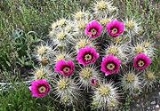
Echinocereus engelmannii
Encyclopedia
The Strawberry Hedgehog Cactus (Echinocereus engelmannii) is commonly found in desert areas of the southwestern United States and the adjacent areas of Mexico, including the states of California
, Nevada
, Utah
, Arizona
, Baja California
and Sonora
. It usually grows in clusters, sometimes up to 20 and more stems. Its bright magenta flowers bloom in April in its southern extremes to late May at northern locations. The flowers are borne at the upper half to one third of the stem. They are funnelform in shape, up to 3.5 inches long with dark-green stigmas
. The fruit is very spiny. At first it is green, becoming pink and drying when ripe. The ripe fruit has spines which are easily detached. The seeds are black, and around a tenth of an inch in size.
The stems are initially cylindrical and erect in young plants, but later with the stem base lying on the ground. The stems are usually 1.5 to 3.5 inches in diameter and up to 25 inches high, and obscured by heavy spines. The plants have around 10 ribs, which are somewhat flattened and tuberculate.
Spines variable in color and size. Radial spines are shorter and needlelike, up to 0.8 inch long, white and arranged in a neat rosette. Central spines number 2 to 7 and are stout, usually twisted or angular, up to 3 inches long and variable in color: bright yellow, dark brown, grey, and white.
Echinocereus engelmannii is commonly used as a landscape plant in its native areas. In pot culture it requires well aerated gritty substrate, and a hot and sunny location in the summer. In the winter the plant easily tolerates light frost and wet (if well-drained) soil. In cultivation it usually does not bloom until it develops 2-3 branches.
California
California is a state located on the West Coast of the United States. It is by far the most populous U.S. state, and the third-largest by land area...
, Nevada
Nevada
Nevada is a state in the western, mountain west, and southwestern regions of the United States. With an area of and a population of about 2.7 million, it is the 7th-largest and 35th-most populous state. Over two-thirds of Nevada's people live in the Las Vegas metropolitan area, which contains its...
, Utah
Utah
Utah is a state in the Western United States. It was the 45th state to join the Union, on January 4, 1896. Approximately 80% of Utah's 2,763,885 people live along the Wasatch Front, centering on Salt Lake City. This leaves vast expanses of the state nearly uninhabited, making the population the...
, Arizona
Arizona
Arizona ; is a state located in the southwestern region of the United States. It is also part of the western United States and the mountain west. The capital and largest city is Phoenix...
, Baja California
Baja California
Baja California officially Estado Libre y Soberano de Baja California is one of the 31 states which, with the Federal District, comprise the 32 Federal Entities of Mexico. It is both the northernmost and westernmost state of Mexico. Before becoming a state in 1953, the area was known as the North...
and Sonora
Sonora
Sonora officially Estado Libre y Soberano de Sonora is one of the 31 states which, with the Federal District, comprise the 32 Federal Entities of Mexico. It is divided into 72 municipalities; the capital city is Hermosillo....
. It usually grows in clusters, sometimes up to 20 and more stems. Its bright magenta flowers bloom in April in its southern extremes to late May at northern locations. The flowers are borne at the upper half to one third of the stem. They are funnelform in shape, up to 3.5 inches long with dark-green stigmas
Gynoecium
Gynoecium is most commonly used as a collective term for all carpels in a flower. A carpel is the ovule and seed producing reproductive organ in flowering plants. Carpels are derived from ovule-bearing leaves which evolved to form a closed structure containing the ovules...
. The fruit is very spiny. At first it is green, becoming pink and drying when ripe. The ripe fruit has spines which are easily detached. The seeds are black, and around a tenth of an inch in size.
The stems are initially cylindrical and erect in young plants, but later with the stem base lying on the ground. The stems are usually 1.5 to 3.5 inches in diameter and up to 25 inches high, and obscured by heavy spines. The plants have around 10 ribs, which are somewhat flattened and tuberculate.
Spines variable in color and size. Radial spines are shorter and needlelike, up to 0.8 inch long, white and arranged in a neat rosette. Central spines number 2 to 7 and are stout, usually twisted or angular, up to 3 inches long and variable in color: bright yellow, dark brown, grey, and white.
Echinocereus engelmannii is commonly used as a landscape plant in its native areas. In pot culture it requires well aerated gritty substrate, and a hot and sunny location in the summer. In the winter the plant easily tolerates light frost and wet (if well-drained) soil. In cultivation it usually does not bloom until it develops 2-3 branches.

